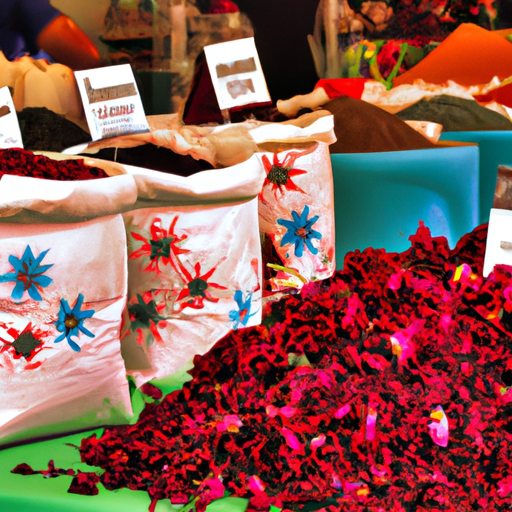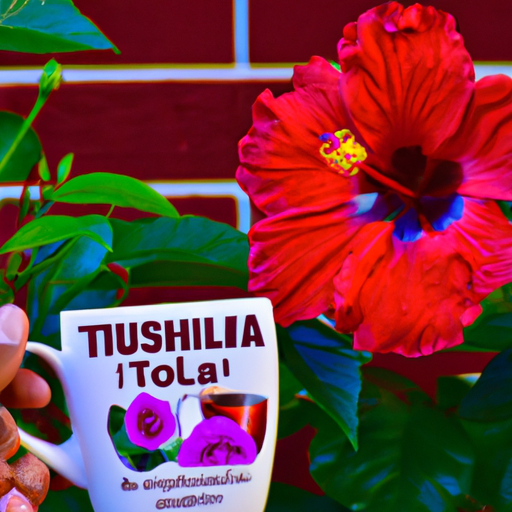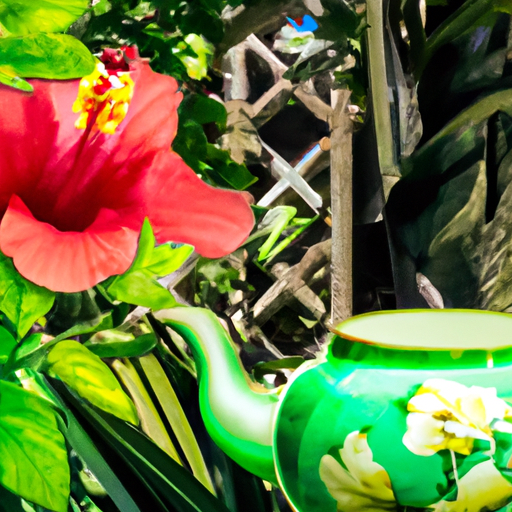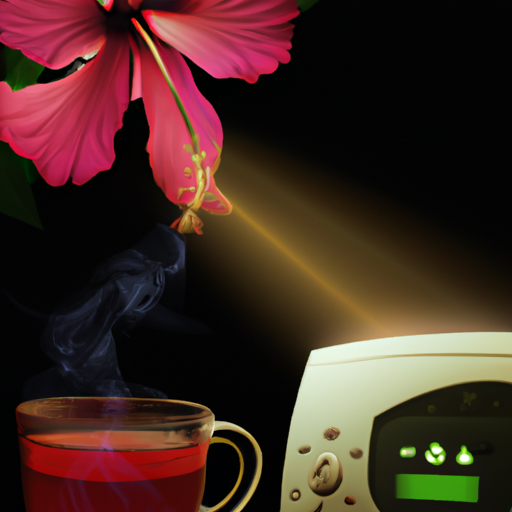I’ve constantly been on the hunt for natural methods to shed pounds and sustain a healthy way of living. Stumbling upon hibiscus tea turned out to be one of the greatest finds for me, owing to its effectiveness in facilitating weight loss.
Hibiscus tea is made from the dried calyxes (the part of the flower that holds the petals) of the hibiscus plant and is known for its tart, cranberry-like flavor. Research suggests that hibiscus tea can help with weight loss by reducing body fat, lowering calorie intake, and improving digestion.
It contains antioxidants called anthocyanins, which help prevent damage to cells from free radicals. Additionally, it has diuretic properties that can help eliminate excess water weight and reduce bloating.
In this article, I will share how to choose and prepare hibiscus tea for optimal weight loss benefits while also discussing other health benefits and potential risks associated with consuming this herbal drink.
Key Takeaways
- Choosing high-quality teas made from whole flowers is important for weight loss benefits
- Proper steeping involves boiling water, adding 1-2 tablespoons of dried hibiscus flowers per cup, and letting it steep for at least 5 minutes before straining
- Opt for organic hibiscus flowers to avoid harmful pesticides and chemicals
- Adding fresh ingredients like ginger or lemon during steeping enhances the taste while also offering additional health benefits
Understanding How Hibiscus Tea Helps with Weight Loss
If you’re looking to shed some pounds, hibiscus tea can be a great addition to your weight loss journey. This tea is made from the dried calyxes of the hibiscus flower and has been shown to have several benefits for those trying to lose weight. However, it’s important to understand both the benefits and drawbacks before adding it to your diet.
One of the main benefits of hibiscus tea for weight loss is its ability to lower blood pressure and cholesterol levels. This can help reduce the risk of heart disease, which is often associated with being overweight or obese.
Additionally, studies have shown that drinking hibiscus tea may also help regulate blood sugar levels and promote healthy digestion.
While there are many potential benefits of hibiscus tea for weight loss, it’s important to note that scientific evidence is still limited. Some studies have shown promising results in terms of weight loss and other health markers, but more research is needed before any definitive conclusions can be drawn.
As with any supplement or dietary change, it’s always best to talk to your doctor before adding hibiscus tea to your routine.
When it comes to choosing the right hibiscus tea for weight loss, there are a few things you should keep in mind. Look for high-quality teas made from whole flowers rather than powders or extracts. You’ll also want to pay attention to how much caffeine is in each serving as too much caffeine can interfere with sleep and potentially hinder weight loss efforts.
Choosing the Right Hibiscus Tea
When it comes to choosing the right hibiscus tea for weight loss, there are a few factors to consider.
First, you’ll need to decide whether you want to use dried flowers or tea bags.
Next, consider whether you prefer organic or conventional options.
Finally, think about the flavors and blends that will best suit your taste buds and health goals.
Personally, I find that using dried flowers and opting for organic blends with natural flavors yields the most satisfying cup of hibiscus tea.
Dried Flowers vs. Tea Bags
Opting for dried hibiscus flowers instead of tea bags can be a game-changer in terms of flavor and potency, giving you more bang for your buck. While tea bags are convenient and easy to use, they often contain lower quality hibiscus that has been ground up into small pieces. This can lead to a weaker brew and fewer health benefits.
Using dried hibiscus flowers allows you to control the steeping process and get the most out of your tea. Proper steeping involves boiling water, adding 1-2 tablespoons of dried hibiscus flowers per cup, and letting it steep for at least 5 minutes before straining. Additionally, storing your dried hibiscus flowers in an airtight container away from light and moisture will ensure freshness and potency over time.
It’s important to note that the health benefits of hibiscus tea go beyond just weight loss. It has been shown to improve heart health, lower blood pressure, and boost immunity. Transitioning into the subsequent section about ‘organic vs. conventional’, it’s worth considering whether or not you want organic or conventionally grown hibiscus flowers for your tea.
Organic vs. Conventional
Whether you’re a health-conscious tea lover or not, choosing between organic and conventional hibiscus flowers can make a significant impact on your overall well-being. Here are four reasons why:
-
Organic hibiscus flowers are grown without the use of harmful pesticides and chemicals, which can negatively affect both our health and the environment.
-
Conventional hibiscus flowers may contain trace amounts of these harmful substances, which can accumulate over time and cause health problems.
-
Organic farming practices promote soil health, biodiversity, and sustainable agriculture, which benefits the entire ecosystem.
-
By choosing organic products, we support farmers who prioritize ethical and environmentally friendly practices.
Overall, opting for organic hibiscus flowers is a simple yet powerful way to prioritize our health and wellbeing while also supporting more sustainable agricultural practices.
As we move into discussing flavors and blends, keep in mind that the quality of the ingredients we choose can greatly impact the taste and nutritional value of our tea.
Flavors and Blends
Indulging in a flavorful and unique blend of hibiscus and other herbs can elevate your tea-drinking experience to a whole new level. Hibiscus tea is not only beneficial for weight loss, but also offers a variety of flavors and blends that cater to different taste preferences. Some of the most popular hibiscus blends include ginger, lemon, mint, and cinnamon.
To emphasize the importance of flavor combinations when brewing hibiscus tea, consider this table:
| Flavor Combination | Herbs/Spices |
|---|---|
| Ginger-Lemon | Ginger root, Lemon peel |
| Minty Fresh | Peppermint leaves |
| Cinnamon Spice | Cinnamon bark |
Each combination brings a unique aroma and taste to the already fruity notes of hibiscus. Brewing techniques also play an important role in bringing out these flavors. For instance, adding fresh ingredients like ginger or lemon during steeping enhances the taste while also offering additional health benefits.
Transition: Now that we’ve explored the various flavors and blends of hibiscus tea, let’s delve into the process of preparing it for weight loss purposes.
Preparing Hibiscus Tea
To make hibiscus tea, you’ll need to boil water and steep the dried flowers for 5-10 minutes. Start by bringing a pot of water to a boil on the stove. Once it reaches boiling point, turn off the heat and add in your dried hibiscus flowers.
Let them steep for at least five minutes, but no longer than ten minutes. There are different brewing methods you can use to prepare hibiscus tea, depending on your preferences. Some like to infuse hibiscus petals with other herbs or spices such as ginger or cinnamon to enhance its flavor and potential health benefits.
Others prefer it plain with just a hint of honey or lemon juice added in for sweetness. Incorporating hibiscus tea into your weight loss routine is simple once you know how to make it properly.
In the next section, we’ll discuss different ways you can enjoy this delicious drink while reaping its full benefits on your journey towards a healthier lifestyle.
Incorporating Hibiscus Tea into Your Weight Loss Routine
Incorporating hibiscus tea into your daily routine is a must if you’re serious about shedding those extra pounds and getting healthier. Not only does this tea provide numerous health benefits, but it can also aid in weight loss.
Here are some benefits and drawbacks of incorporating hibiscus tea into your weight loss routine:
-
Benefits:
-
Acts as a natural diuretic: Hibiscus tea contains compounds that help flush out excess water from the body, reducing bloating and aiding in weight loss.
-
Boosts metabolism: Studies have shown that consuming hibiscus extract can increase metabolic rate, leading to more calorie burn and faster weight loss.
-
Drawbacks:
-
Can cause dehydration: Due to its diuretic properties, too much consumption of hibiscus tea can lead to dehydration. It’s important to drink plenty of water along with the tea.
-
Interferes with certain medications: Hibiscus tea may interfere with some medications such as antihypertensive drugs. Always check with your doctor before adding this or any other supplement to your diet.
While hibiscus tea is a great addition to your weight loss routine, it’s important to remember that no single method will work for everyone. Alternative methods such as exercise and healthy eating habits should also be incorporated for maximum results.
In the next section, we’ll explore other health benefits of hibiscus tea beyond just weight loss.
Other Health Benefits of Hibiscus Tea
Discover the amazing health benefits that hibiscus tea can offer you beyond just weight loss. This herbal tea is packed with essential vitamins and minerals that make it a great addition to your daily diet.
Hibiscus tea is rich in antioxidants, which can protect your body against harmful free radicals and reduce inflammation, thus lowering your risk of chronic diseases such as heart disease, cancer, and diabetes. In addition to its antioxidant properties, hibiscus tea also has anti-inflammatory effects that may help improve your heart health by reducing blood pressure levels and lowering cholesterol levels.
Studies have shown that drinking hibiscus tea regularly may help lower systolic blood pressure by up to 10 points in people with high blood pressure. The nutritional value of this beverage doesn’t stop there; it’s also an excellent source of vitamin C, iron, and calcium.
Overall, incorporating hibiscus tea into your daily routine can offer numerous health benefits beyond just shedding pounds. However, it’s essential to note that like any other herbal supplement or medication, there are potential risks and side effects associated with consuming too much hibiscus tea. Let’s explore these further in the next section.
Potential Risks and Side Effects
Congratulations, you’ve decided to explore the potential risks and side effects of consuming too much hibiscus tea – it’s always better to be informed than to blindly consume something for its benefits! While hibiscus tea is generally safe and well-tolerated by most people, there are some risks and precautions you should be aware of.
Firstly, drinking excessive amounts of hibiscus tea may lead to low blood pressure or hypotension. This is because hibiscus tea has natural diuretic properties which can cause the body to lose more fluid than usual. If you already have low blood pressure or take medication for hypertension, it’s advisable to consult with your doctor before adding hibiscus tea to your diet.
Secondly, hibiscus tea contains organic acids that may irritate the stomach lining in certain individuals. Drinking large quantities of this beverage on an empty stomach could lead to nausea, vomiting or diarrhea. To minimize these risks, try drinking smaller amounts at first until you know how your body will react. Additionally, it’s important not to drink too much hibiscus tea before bedtime as it might interfere with sleep quality due to its caffeine content.
While there are some potential risks associated with consuming too much hibiscus tea, they are generally mild and easily avoidable by taking a few simple precautions.
Now that we’ve covered this topic in detail, let’s move on to the next section where I’ll share some tips for making the most of hibiscus tea for weight loss without compromising your health and wellbeing.
Tips for Making the Most of Hibiscus Tea for Weight Loss
As I’m continuing to incorporate hibiscus tea into my weight loss journey, I’ve found it helpful to track my progress and adjust my habits accordingly.
Experimenting with different recipes has also been a fun way to keep things interesting and avoid getting bored with the same old routine.
Additionally, finding ways to incorporate hibiscus tea into social settings has allowed me to enjoy the benefits of this healthy beverage while still maintaining my social life.
Tracking Progress and Adjusting Habits
To make progress with your weight loss goals, it’s important to regularly track your habits and adjust them as needed. This means keeping a record of what you eat and drink throughout the day, as well as any physical activity you engage in. You can use a smartphone app or a journal to keep track of these things.
By doing so, you’ll be able to identify patterns in your behavior that may be hindering your weight loss progress. Once you’ve identified areas for improvement, start adjusting your habits accordingly. For example, if you notice that you tend to snack on unhealthy foods during certain times of the day, try replacing those snacks with healthier options like fruits or vegetables.
Or if you find that you’re not getting enough physical activity each day, try incorporating more movement into your routine by taking walks or practicing yoga. By tracking progress and adjusting habits in weight loss regularly, you’ll be able to stay on track towards achieving your goals and living a healthier lifestyle overall.
And speaking of healthier options, let’s move onto our next topic: experimenting with different recipes!
Experimenting with Different Recipes
Now it’s time for me to spice up my meal plan and try out new recipes that will excite my taste buds and keep me on track towards a healthier lifestyle.
When it comes to hibiscus tea, there are various infusion techniques and flavor pairings that can make the drink even more enjoyable. Adding mint leaves or ginger can add a refreshing twist, while cinnamon or cloves can enhance the warmth of the tea. Honey or stevia can provide sweetness without adding calories.
Another way to experiment with hibiscus tea is by cold-brewing it overnight in the fridge with sliced fruits such as oranges or strawberries. This creates a deliciously fruity and refreshing drink that can replace sugary sodas or juices.
By trying out different recipes and incorporating hibiscus tea into my daily routine, I’m able to satisfy my cravings while still staying true to my weight loss goals. As I continue on this journey, I’m also learning how to incorporate hibiscus tea into social settings without feeling left out.
Incorporating Hibiscus Tea into Social Settings
Adding a little flavor to my social gatherings, I’ve found that incorporating hibiscus tea into the mix is like adding icing on the cake.
Not only does it provide a refreshing and healthy drink option, but it also adds a pop of color and flavor to any occasion.
When socializing with hibiscus tea, there are several serving suggestions to consider.
One option is to serve it cold over ice with sliced fruit or herbs for added flavor and visual appeal.
Another idea is to create a signature cocktail by mixing hibiscus tea with your favorite spirit and garnishing with fresh citrus or berries.
Whether you’re hosting a dinner party or just having friends over for drinks, hibiscus tea is sure to be a crowd-pleaser.
Frequently Asked Questions
Can hibiscus tea be consumed hot or cold for weight loss?
I’ve found that hibiscus tea can be consumed either hot or cold for weight loss. It really just depends on your personal preference!
When consuming it hot, I like to mix it with other teas such as green tea or peppermint tea to add some flavor and variety. However, when drinking it cold, I find that adding some lemon juice or honey can make for a refreshing and tasty beverage.
Ultimately, whether you choose to drink it hot or cold won’t affect the weight loss benefits of hibiscus tea – so go ahead and enjoy it however you prefer!
Is it safe to drink hibiscus tea while pregnant or breastfeeding?
As a healthcare provider, I understand the importance of ensuring safety while pregnant or breastfeeding.
When it comes to hibiscus tea, there are possible risks and benefits to consider. Hibiscus tea may lower blood pressure, which can be beneficial for those with hypertension. However, consuming large amounts of hibiscus tea can also lead to hypotension, which is not recommended during pregnancy or breastfeeding.
Additionally, some studies suggest that hibiscus tea may have an effect on estrogen levels, potentially impacting fetal development. Therefore, it’s important to take precautions and consult with a healthcare provider before consuming hibiscus tea while pregnant or breastfeeding.
How much hibiscus tea should be consumed daily for weight loss?
When it comes to daily intake of hibiscus tea for weight loss, there’s no set amount that works for everyone. However, studies have shown that consuming up to 3 cups a day can be beneficial in reducing body weight and improving overall health.
It’s important to note that the timing of consumption may also play a role in its effectiveness. For example, drinking hibiscus tea before meals may help with appetite control and lead to reduced calorie intake.
As with any dietary change, it’s best to consult with a healthcare professional before incorporating hibiscus tea into your daily routine.
Can hibiscus tea be combined with other weight loss drinks?
Combining hibiscus tea with other weight loss drinks can be a great way to enhance your results. When it comes to green tea, the benefits are clear. It contains powerful antioxidants and catechins which boost metabolism and aid in fat oxidation.
By combining it with hibiscus tea, you’ll also reap the benefits of increased hydration and reduced inflammation. However, it’s important to be cautious when mixing hibiscus tea with energy drinks or supplements that contain caffeine as this could lead to negative side effects like jitters or increased heart rate.
Overall, incorporating hibiscus tea into your weight loss routine is a smart move – just make sure to choose compatible companions for optimal results!
Are there any dietary restrictions that need to be followed while drinking hibiscus tea for weight loss?
When it comes to drinking hibiscus tea for weight loss benefits, there are some dietary restrictions that should be considered.
For example, hibiscus tea can lower blood pressure and may interact with certain medications. Additionally, hibiscus tea is a natural diuretic and may cause dehydration if not consumed with enough water.
It’s important to drink plenty of water throughout the day when incorporating hibiscus tea into your diet for weight loss purposes.
Overall, while hibiscus tea can provide numerous health benefits including aiding in weight loss, it’s important to consult with a healthcare professional before making any significant changes to your diet or exercise routine.
Conclusion
So there you have it, folks! Hibiscus tea is a powerful tool in your weight loss journey. Not only does it help to lower your calorie intake and reduce fat accumulation, but it also provides a host of other health benefits.
From reducing blood pressure to improving liver function, hibiscus tea is truly a wonder drink! But don’t just take my word for it. Try incorporating hibiscus tea into your daily routine and see the results for yourself.
Remember to choose high-quality tea leaves, prepare it correctly, and make adjustments to suit your own tastes and preferences. With patience and persistence, you can achieve your weight loss goals while enjoying all the benefits that this delicious beverage has to offer.
So why not give it a try today?










